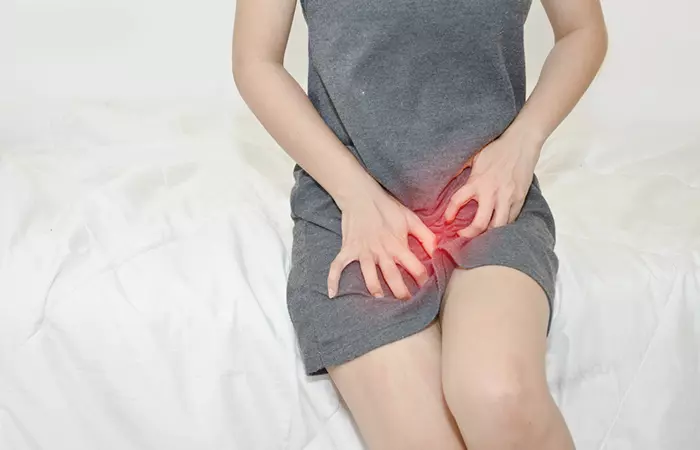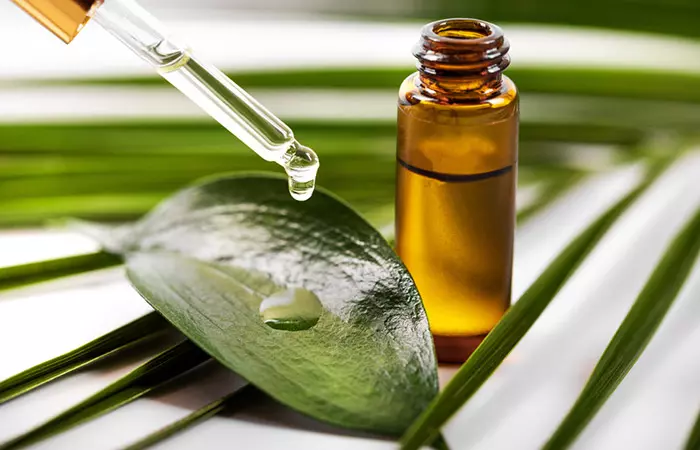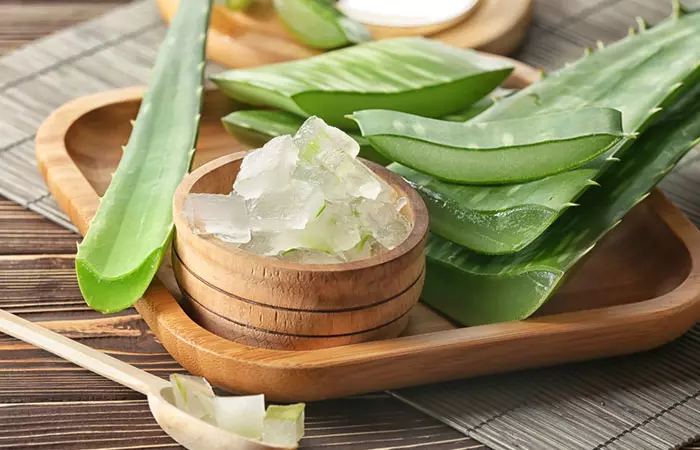A yeast infection can happen to anyone and affect the warm and moist areas in the body, but women tend to have vaginal yeast infections more often. Yeast infection is usually caused by the fungus Candida and affects as many as 75 out of 100 women worldwide (1). While women are more prone to it, men can sometimes get it as a sexually transmitted disease. If you doubt that something is off down there, you can opt for a medical diagnosis or begin treatment by trying some of the vaginal yeast infection home remedies given below. Read on to know more in detail.
Types Of Yeast Infections
Yeast infections can be of various types, depending on the affected part of the body or the strain of yeast causing the infection. The most common types of yeast infections include:
Candida auris: This is an invasive and difficult to treat yeast infection caused by a strain of yeast known as candida auris. Candidemia: Candidemia is the condition where the yeast infection is present in the bloodstream. Genital/Vulvovaginal Candidiasisi A yeast infection brought on by a fungus, candida that lives on the skin and inside the body but usually doesn’t cause any problem. : An yeast infection in the genitalia or the vagina is commonly referred to as genital or vaginal candidiasis. Invasive Candidiasis: This is a serious yeast infection that spreads to the heart, lungs, eyes, brain and other parts of the body from the bloodstream.
Oral Thrush (Oropharyngeali Concerning the region of the throat (pharynx) that is situated between the soft palate in the mouth and the hyoid bone. Candidiasis): Oral thrush is yeast infection in the mouth or throat which presents white patches as the most common symptom. Esophageal Candidiasis: Candidiasis, or a yeast infection caused by Candida in the esophagus (the tube connecting the throat and the stomach) is called esophageal candidiasis. Tinea Versicolori Frequent skin fungal infection that disrupts the skin’s normal pigmentation, causing tiny, discolored areas. : This is a fungal infection of the skin.
Dr. Laura Purdy , MD, MBA, a board-certified family physician, says, “It is very rare, but yes, it is possible to have a yeast urinary tract infection. Usually, this is only seen in people who have a suppressed immune system.”
What Causes Yeast Infections? What Is Candida albicans?
Yeast infections are caused by a type of fungus called Candida. This fungus has about 20 different strains that cause infections in different parts of the body. Candida albicans is the strain that is most commonly responsible for yeast infections, especially vaginal yeast infections (2). Vaginal infections are generally sexually transmitted infections. However, that is not the case with yeast infections. Dr. Laura says, “A yeast infection is not considered to be an STD, because anyone with a vagina can get a yeast infection at any time. If your partner has an infection, it can spread from person to person, but in and of itself, a yeast infection is not considered to be a yeast infection.” Under the influence of antibiotics, cortisone drugs, and other over-the-counter treatments, yeast can overgrow in the intestines and migrate to the vagina. That’s why it’s important to maintain vaginal health and treat vaginal yeast infections both locally and body-wide. A study conducted on 3,079 women revealed that 10.5% of women faced a vaginal infection during pregnancy. 8.1% of the women experienced one or two infections and 2.4% experienced recurrent infections during their trimesters.The study showed that infection prevalence ranged from 4.3% in the first trimester to 6.8% in the second and 5.0% in the third. Let us now take a look at vaginal yeast infection symptoms.
What Are The Signs And Symptoms Of A Yeast Infection?
Yeast infection is also known as candidiasis. It can occur on any part of the body. It is most commonly seen in the oral parts or genitals. Oral yeast infection, or oral thrush, has the following symptoms:
White patches in the mouth Difficulty in swallowing food Pain in the infected part
The signs and symptoms of a vaginal yeast infection are as follows:
Unbearable itchiness in and around the vagina Swelling, redness, and burning of the affected area White discharge that looks like cottage cheese but has no smell Burning sensation or pain while urinating Pain during sex Soreness
How Is A Vaginal Yeast Infection Diagnosed?
According to Dr. Laura, “There are a few home tests that can check the pH of the vaginal secretions and can suggest to you whether it is more likely that you would have a yeast infection or a bacterial vaginosis infection. But to my knowledge, there are not any tests available at home. Use that directly to check for the presence of a yeast infection.” To diagnose a yeast infection, your healthcare provider may ask you questions about your medical history to gather information regarding past vaginal infections. This may be followed up by a pelvic examination which involves close examination of the vagina and the cervix for signs of infection. In some cases, a sample of your vaginal fluid may be collected for testing so that the type of fungus causing the infection may be identified. After the diagnosis, your doctor may prescribe you medications or you may seek guidance regarding the use of home remedies to treat the infection. Listed below are some home remedies that can be used as part of your yeast infection treatment and help relieve the symptoms.
Home Remedies For Yeast Infection
1. Apple Cider Vinegar
Why Does It Work? ACV possesses antifungal properties against Candida (3). Therefore it may help facilitate recovery from yeast infection when applied topically. In addition, when consumed in an undiluted or mildly-diluted manner, it may promote a hostile environment for certain Candida species (yeast) and curb their growth (4), (5). Note: Undiluted ACV may irritate the sensitive vaginal area, so it should be used with caution and in a properly diluted manner. You Will Need
1-2 tablespoons apple cider vinegar A glass of water
What You Have To Do
Mix the ACV in the water and drink it up. Alternatively, mix one cup of ACV in a lukewarm bath and soak in it.
How Often You Need To Do This Do this 2-3 times a day.
2. Garlic
Why Does It Work? Garlic exhibits strong antifungal activity against Candida species, making it an effective option when using garlic to treat a yeast infection (6), (7). You Will Need
2-3 cloves garlic Water
What You Have To Do Swallow 1-2 garlic cloves with water. How Often You Need To Do This Do this 1-2 times a day. Caution: Do not use the garlic paste on sensitive areas, such as the vagina and inner thighs.
3. Boric Acid
Why Does It Work? Boric acid powder in solution is mild enough to use as an eyewash, and it also kills yeast (antifungal) and viruses (antiviral). It is recommended by doctors when most antifungals fail to cure yeast infection (8). You Will Need
Boric acid powder Gelatin capsules
What You Have To Do How Often You Need To Do This Do this for 12-15 days to completely clear out the infection. Caution: Boric acid in high doses is toxic orally, so it’s best not to ingest these capsules. Also, do not use this home remedy if you are pregnant.
4. Tea Tree Oil
Why Does It Work? This is yet another favorite amongst naturopaths. Essential oils are a good source of important bioactive compounds and include some of the best natural remedies for yeast infection. Tea tree oil is antifungal, antiviral, and antibacterial (9). Along with the honey or warm water, it also soothes the inflamed skin. You Will Need
3 drops tea tree oil 2 tablespoons honey
What You Have To Do How Often You Need To Do This Do this for a few nights before going to bed. Caution: Tea tree oil is extremely potent. Do a patch test and wait until 24 hours to notice any reaction.
5. Yogurt And Probiotic Combination Therapy
Why Does It Work? A combination of yogurt and honey was found to relieve a few symptoms of yeast infection (10). Another study showed that consuming yogurt could help reduce the spread of Candida fungi (11). Note: While there is some evidence to support the topical application of yogurt for the treatment of yeast infections, it should be used with caution. The natural sugars present in yogurt and honey (in the case of combination use) may aggravate a yeast infection in some individuals, especially when applied to the vagina. You Will Need
Plain yogurt Cotton tampon
What You Have To Do How Often You Need To Do This Repeat this every few hours.
6. Coconut Oil
Why Does It Work? Coconut oil can help in treating fungal infections caused by drug-resistant Candida strains (12). It showed significant antifungal activity against Candida albicans, which is comparable with ketoconazole (13). You Will Need Virgin coconut oil What You Have To Do How Often You Need To Do This Do this 2-3 times a day.
7. Epsom Salt Bath
Why Does It Work? Epsom salt is essentially magnesium sulfate. This chemical salt is capable of killing yeast and treating the infection (14). You Will Need
2 cups Epsom salt Bathtub (full of warm water)
What You Have To Do How Often You Need To Do This Repeat this 3 times a week.
8. Oil Of Oregano
Why Does It Work? Oregano oil is one of the most potent oils that can keep the infection from spreading from the anus to the vagina as yeast overgrows in the large intestines. Its phenolic components, namely carvacrol and thymol, exert fungicidal effects on the yeast causing the infection (15). You Will Need
3 drops of oregano oil A glass of water
What You Have To Do Add the oil to the glass of water and drink it. How Often You Need To Do This Drink this 2 times a day for a week. You can increase the dose to up to 6 drops per glass of water. Caution: Before using oregano oil for pregnant women and children, please consult your doctor.
9. Aloe Vera
Why Does It Work? Aloe vera gel can help soothe irritation and alleviate inflammation in the affected area. It also displays antifungal effects on C.albicans (16). You Will Need Fresh aloe vera gel What You Have To Do How Often You Need To Do This Reapply 2-3 times a day.
10. Peppermint Oil
Why Does It Work? This is an excellent remedy for oral thrush, also called oral yeast infection. Peppermint oil contains compounds that exhibit therapeutic potential against Candida-related infections (17). You Will Need
2-3 drops peppermint oil 8 oz. of water
What You Have To Do How Often You Need To Do This Do this 2 times a day.
11. Green Tea
Why Does It Work? Green tea contains catechins that strengthen the body’s immune system and help it to fight yeast infection (18), (19). Drinking green tea will quicken the elimination of the yeast from your body. The topical application of green tea can reduce inflammation and soothe the skin in the affected area (20). You Will Need
Green tea (loose or tea bag) A cup of hot water
What You Have To Do How Often You Need To Do This Drink 2-3 cups of this herbal tea in a day.
12. Baking Soda
Why Does It Work? Baking soda has strong antifungal properties that may inhibit the growth of Candida albicans (21). It is also said to have anti-inflammatory properties that may help relieve the irritation and discomfort caused by a yeast infection. You Will Need
1-2 tablespoons of baking soda Water (as needed to form a paste-like consistency)
What You Have To Do How Often You Need To Do This Do it as needed to alleviate irritation and itching. If you wish to keep yeast infections at bay or want to treat an infection that doesn’t seem to abate, make small changes in the way you eat.
What To Eat To Treat Yeast Infections
Including certain foods in your diet may help you avoid or recover quickly from yeast infections. For instance, fermented foods that contain natural probiotics can help eliminate yeast. These include:
Kefir Yogurt Kimchi Sauerkrauti Finely chopped raw cabbage that has been fermented by different lactic acid bacteria and is a great source of fibers and vitamins. Pickles
You should also consume the following:
Garlic Coconut oil Cranberries Cruciferous vegetables such as broccoli, cauliflower, cabbage, bok choy, arugula and brussels sprouts A low-sugar diet
While most home remedies and recommended dietary changes can help treat mild to moderate yeast infections, there are some popular home remedies that should be avoided as either they are not well studied for efficacy or they are unsafe and may cause further complications. Let’s look at some of them.
Home Remedies That Don’t Treat Yeast Infections
Douching With Hydrogen Peroxide
Using hydrogen peroxide for yeast infection may seem like a quick solution, but it can kill the natural bacteria present in the vagina. This may in turn lead to recurrent yeast infections as a healthy bacterial population in the vagina helps fight off unwanted microbial growth. .
Douching With Feminine Hygiene Products
Many feminine hygiene products claim to help curb vaginal yeast infections. However, there is little evidence to support their use. The vagina is a self-cleaning organ and these products may hamper the natural pH of the vagina, destroy healthy bacterial growth and exacerbate yeast infections in some cases. Do not use these unless directed by a physician. Yeast infections may recur despite using home remedies or alternate treatment methods if certain precautions are not taken. To enhance your efforts, consider following essential tips for a healthy vagina. These practices can help prevent vaginal yeast infections from developing or recurring.
Preventing Vaginal Yeast Infections
Follow good hygiene practices. Eliminate foods rich in refined carbs and sugars from your diet. Lucy Foster, a blogger, recalls how she mitigated a candida infection. She talks about dealing with chronic allergic rhinitis, a hormonal imbalance, and the teenage problem of thrush that led to candida. Her nutritionist examined her and advised a low-sugar and healthier diet. She adds, “At the time I was 14 and was advised to cut down sugar…She suggested I incorporate more plants into my diet, recommended supplements for my hormones, and that was that (i).” Stay away from alcohol. Avoid douching or using soap inside the vagina. Wear well-fitted (not too tight) and breathable cotton underwear. Avoid wearing sweaty or wet clothes for long periods and change out of them as early as possible. Avoid the use of scented soaps and detergents. Replace pads and tampons frequently. Practice wiping from the front to back while using the bathroom. Avoid extremely hot baths or prolonged time in hot tubs.
Despite taking preventive measures or applying home remedies and dietary changes, there may be instances where it is in your best interest to consult your healthcare provider regarding suspected yeast infection.
When To Contact A Doctor
It is recommended to contact a doctor if:
This is your first yeast infection. Home remedies do not seem to be working for you. The symptoms persist beyond a week. You are experiencing recurring yeast infections. You are pregnant and have the symptoms of a vaginal infection. You are unsure about whether your infection is bacterial or fungal. Your previous medications for yeast infections do not seem to be working.
Can a yeast infection turn into bacterial vaginosis (BV)? According to Dr. Laura, “A yeast infection cannot turn into BV. They are two completely different infections. Yeast is caused by a fungus and BV is caused by an overgrowth of bacteria. It’s actually possible to have both of these conditions occurring at the same time, but one cannot turn into the other. Occasionally, we might see where someone is getting treatment for one, and they develop the other, because of the fact that the vaginal flora is altered in the course of treatment. But outside of this circumstance, it’s not possible for one to become the other.” How long do yeast infections last? When a yeast infection is left untreated, the symptoms do not vanish on their own. They may become worse and cause more complications. Using home remedies or proper antifungals is recommended. Depending on the type of treatment you are using, it may take any time between three to seven days for the infection to clear. What is the fastest way to get rid of a yeast infection? The fastest way to get rid of a yeast infection involves the treatment with a prescription antifungal medication such as Fluconazole. Can yeast infections go away on their own? Mild cases of yeast infections may clear away on their own within a couple of weeks. However, if you are pregnant, you should seek treatment and not wait for it to clear on its own. What happens if a yeast infection is left untreated? It depends. In some mild cases, a yeast infection may resolve on its own. In other cases, it may progress to more severe infection and cause complications. Can a yeast infection turn into an STD? No, a yeast infection will not turn into an STD. This is because it is caused by the Candida fungus. However, you can pass a yeast infection to your partner. How often should you shower with a yeast infection? You may shower once or twice a day. However, do not wash your vaginal area more than once a day if you have a yeast infection to prevent worsening the infection. What soap is good for yeast infection? Antifungal and unscented soaps are the best options for yeast infections. However, ensure you do not use soap inside the vagina. Just cleanse the external area of your vulva with warm water and a mild soap. Can hot water kill yeast infection? Anecdotal evidence suggests that hot water may reduce irritation, itching, and discomfort temporarily. But there is no evidence that hot water kills yeast infections. Hence, more research is warranted to support this claim. Learn how to treat vaginal yeast infection at home with these 5 natural remedies. Get rid of the itching and burning with these easy tips. Watch this informative video below.












